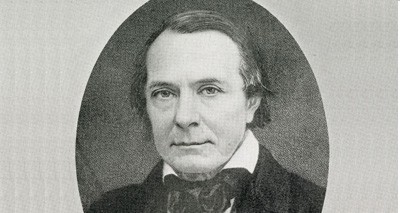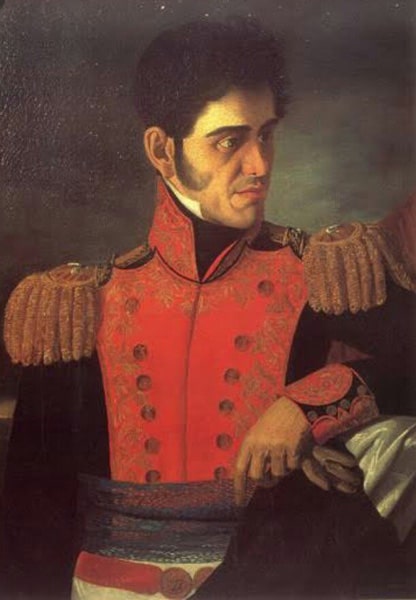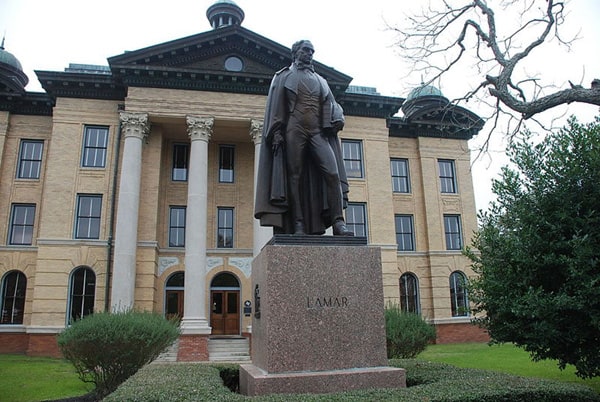Mirabeau Lamar: A Southern Beau Idéal
Sinclair Jenkins, American Renaissance, December 13, 2019

They don’t make ‘em like they used to. This hackneyed phrase applies to the Anglo men who led the Texas Revolution. Between 1835 and 1836, a few thousand American settlers defeated the professional army of Mexico commanded by the “Napoleon of the West,” General Antonio Lopez de Santa Anna. One of the chief architects of this successful revolution was Mirabeau Buonaparte Lamar — a Georgia native who later became the president of the independent Republic of Texas. Lamar had a vision of an independent Texas free of the “Yankee tyranny” of the United States, but later approved of annexation. Throughout his life he was an example of the unique spirit of Anglo Texas.
Lamar was born in the tiny town of Louisville, Georgia, in 1798 and grew up on his father’s plantation near Milledgeville. The South valued honor, breeding, and bravery. Second and third generations of settlers created a hierarchy that was not based on lineage and titles, but on the accomplishments of men and their children. The South was the land of militia captains, tough settlers, and successful plantation owners. The Lamars were Southern to the core.
Mirabeau and his family moved to the growing city of Columbus, Georgia, where Lamar founded the Columbus Enquirer in January 1828. The newspaper was an instant success. Lamar considered running for the Georgia senate, but two tragedies thwarted him. In 1830, Mirabeau’s young wife Tabitha caught tuberculosis and died. Two years later, Lucius Q.C. Lamar, Mirabeau’s brother, committed suicide. Grief inspired Lamar to write morbid poems and drove him west, ultimately into Texas.
Texas was sparsely populated in the early 19th century. Few Spaniards or Mexicans wanted to live there because of frequent Comanche raids, but the Mexican government wanted subjects north of the Rio Grande in order to develop the area’s vast resources. The solution: recruit Anglo-American settlers.
As early as the 1790s, New Spain asked English-speaking American Protestants to settle in the wilds of Upper Louisiana (Missouri). The Spanish wanted those settlers to work the land and trade with other Anglos in the new American Republic. In return, Spain required that settlers become Roman Catholic.
The situation was similar in Texas in the 1820s. The newly independent Mexican Republic wanted Americans to create new settlements in Texas in addition to the three existing towns of Nacogdoches, San Antonio de Bexar, and La Bahia del Espiritu Santo (later renamed Goliad). Cheap land attracted American settlers. They “could claim . . . 4,605 acres . . . at a cost about four cents an acre ($184) payable in six years, a sum later reduced by state authorities” [4]. Mexico followed in the footsteps of Spain, and the Mexican Constitution of 1824 required all Mexican citizens to become Catholic. One English-speaking priest, Michael Muldoon, was sent to live among the Anglo-Texans in the eastern half of the state. Some converted; others remained Protestant. Many Americans expected eastern Texas to be annexed by the US eventually, while others thought Texas had already been ceded to the United States as part of the Louisiana Purchase.
By 1825, Stephen F. Austin, the Virginian who brought the first Anglo families to Texas, established Austin with 300 families, mostly from the South. These families became the known as the Old Three Hundred. As thousands more American settlers established communities in Mexican Texas, they formed militias to protect against Comanche and Mexican raiders from beyond the Rio Grande. These militias were the nucleus of the Texas Rangers.
Lamar arrived in Texas ten years later in 1835. By that time, revolution was in the air. Santa Anna, who had become a Mexican hero after defeating a Spanish attempt to regain its lost possessions, was elected president in 1833 as a Federalist. He suspended the 1824 Constitution and ruled as a military dictator after a coup against his own government. One of his first decrees was to reduce the size of the state militias in Mexico. This was a political move, because his opponents the Liberals wanted to turn the state militias into a body separate from the Mexican Army, which was controlled by Santa Anna’s Federalists. The state of Zacatecas rebelled against Santa Anna’s authoritarian rule, but Santa Anna’s army crushed the state’s 4,000 militiamen [5].

Antonio Lopez de Santa Anna
The Texians (the name for the Anglo settlers) also rebelled. These men and women were used to government, and saw Santa Anna as an illegal tyrant. Even though he had suspended the 1824 Constitution that required Catholic conversion and was an enemy of the Catholic church, Santa Anna marched his army into Texas in 1835 on the pretext that Texians had violated the constitution by not converting. He was determined to rid Texas of Anglo colonists [6].
After the Alamo, Santa Anna’s army defeated the rag-tag Texian army at the Battle of Coleto of March 19-20, 1836. The Mexicans executed some 300 Texian prisoners after the battle in what become known as the Goliad Massacre. One of those killed was James W. Fannin, the man Lamar followed into Texas. The massacre convinced Lamar to join the Texian Army, and became a rallying cry for the rebels.
In April 1836, Lamar started out as a private in the Texian Army, but before the month was out, he was a colonel in charge of the Texian cavalry. He was promoted because he helped save two Texas soldiers who were surrounded by Santa Anna’s troops before the Battle of San Jacinto. One was Thomas Jefferson Rusk, the future Texas Secretary of War. The battle itself lasted just 18 minutes. Santa Anna fled but was captured the next day, and agreed to recognize Texas independence.
Lamar served faithfully under General Sam Houston, but became his chief political opponent. On December 10, 1838, Lamar was sworn in as the second President of Texas — after Houston — and found himself the leader of a war-weary, and undeveloped land. As the Texas State Library and Archives Commission puts it:
The republic had no money, no commercial treaties, no international recognition except from the United States and no prospects of annexation by the U.S. Texans were under constant Indian attack. Mexico did not recognize Texas independence and threatened invasion and reconquest. Lamar, however, was nothing if not a romantic. In Lamar’s eyes, a broke and scarcely viable country would grow into a Texas empire that would stretch to the Pacific Ocean. A collection of log cabins at the westernmost edge of settlement would become a grand new capital, Austin. The children of a rough and hardscrabble population would attend public schools and universities, funded by Texas’s vast wealth in land.
Under Lamar, the state established an education system. Lamar is today known as the “Father of Texas Education;” he was self-taught and loved books and learning. The published poet and former newspaper owner convinced the Texas Legislature to set aside land in each county for schools. He also reserved land for two states universities: Texas A&M and the University of Texas [7].

Statue of Mirabeau Lamar at the Fort Bend County Courthouse. Wikimedia Commons/Adavyd.
President Lamar was also “an inveterate enemy of Cherokees.” One of his first acts was to demand that the Western Cherokees be removed from Texas to Oklahoma in order to prevent a Mexican alliance with the tribe (Mexican General Valentin Canalizo had such a plan) [8]. After the removal, Lamar successfully used the small Texas Army, militia, and Texas Rangers against both the Comanche and Mexican revanchists, but his expedition to Santa Fe failed. Texans hoped to persuade New Mexicans to renounce Mexican citizenship and join Texas. In 1841, the Santa Fe Pioneers crossed into Mexican territory, but militia easily captured the thirsty and weary men. The prisoners were sent to Mexico City and held until the following year. Many died on the march to Mexico.
Lamar’s daughter died in 1843, and he again turned to poetry, publishing “On the Death of My Daughter” in the Southern Literary Messenger, which had first published Edgar Allan Poe.
During the Mexican-American War, Lamar fought under General Zachary Taylor. At the Battle of Monterrey in 1846, he once again showed his courage as captain of the Texas Mounted Volunteers. After the acquisition of the American southwest, Lamar argued for the expansion of Southern culture, including slavery. Lamar was, himself, a slaveholder, and promoted the plantation economy. President Buchanan thought so highly of Lamar that he appointed him minister to Nicaragua and later to Costa Rica. He returned to Texas because of poor health and died on his plantation in 1859.
Mirabeau B. Lamar was both an intellectual and a soldier, who devoted his life to his beloved Texas. He was of that generation of men who fought for Texas liberty, the best of the South’s founding stock of English Cavaliers and Scots-Irish frontiersmen. It was men like him who built this country, and men like him will save it.
* * *
[1]: Perdue, Theda and Michael D. Green, The Cherokee Nation and the Trail of Tears (New York: Viking, 2007): 74.
[2]: Lowden, E.M., “The Eternal Anglo IV,” The New American Sun, 7 Nov. 2019.
[3]: Ibid.
[4]: Henson, Margaret Swett, “Anglo-American Colonization,” Texas State Historical Association, 30 June 2016.
[5]: Scheina, Robert L., Santa Anna: A Curse Upon Mexico (Washington, D.C.: Brassey’s, 2002): 25.
[6]: Hardin, Stephen L., Texian Iliad: A Military History of the Texas, 1835-1836 (Austin: University of Texas Press, 1996): 152.
[7]: Hendrickson, Kenneth E., Chief Executives of Texas: From Stephen F. Austin to John B. Connally, Jr. (College Station: Texas A&M University Press, 1995): 35.
[8]: Everett, Dianna, The Texas Cherokees: A People Between Two Fires, 1819-1840 (Norman: University of Oklahoma Press, 1990): 100.















